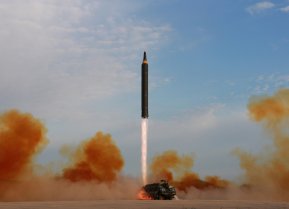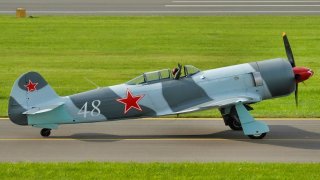Meet the Yak-3: Russia's Most Dangerous World War II Fighter?
While the Yak series of fighters were among the most produced aircraft of the Second World War, only some 5,000 were in the Yak-3 configuration.
Meet Russia's Yak-3 fighter from World War II: During the Second World War, the Yaks proved to be the most important fighter in the Soviet arsenal. Production began on the single-seat aircraft in the 1930s, and the prototype I-26 was first flown in January 1940. Almost expectedly, an emphasis was placed due to the use of cheap materials.
The first of the modern Yak fighters, the Yak-1 came into service just in time to meet the German invasion in June 1941. Agile and fast, the Yak was the best of the new Soviet fighters, and with a skilled pilot it was more than able to equal the German's Bf 109 or Fw 190 in a dogfight. In addition, the Soviet fighter proved useful as ground-attack aircraft.
As the war progressed, the Yak-1 only improved as the Yak-3. It had its rear fuselage cut down and a simple clear-view canopy fitted, which offered its pilots a much-improved field and vision. In addition, the latter version's wing was reduced in size, but with aerodynamic refinements including a new placement of the oil radiator.
The Yak-3 went on to be one of the war's most agile fighters.
Yak-1M
The Yak-1 was significantly upgraded as the Yak1M, but was redesignated the Yak-3 and it became one of the most feared foes of Luftwaffe pilots on the Russian Front. It was first flown on September 30, 1943, and it entered service the following year. The Yak-3 was equipped with a Klimov VK-105PF2 V2 liquid-cooled piston engine rated at 1290hp giving a top speed of 401mph over a combat range of 340-miles.
In addition to being a speedy aircraft, the Yak-3 was also able to take a significant amount of damage and remain airworthy.
Yak-3: Well Armed
Armament of the Yak-3 comprised a single 20mm (.79-inch)) ShA-20M cannon, which fired through the propeller spinner – which replaced the ShVAK of the earlier Yak-1s – while the aircraft was also equipped with two UBS 12.7mm (.50 caliber) machine guns located in the upper fuselage.
In addition to the better field of vision, the upgraded jettisonable hood was also less prone to jamming than those of the first model. A sheet of 9mm (1/3-inch) back armored steel also protected the pilot from enemy fire.
Improved Materials
The Yak-3 utilized an all-metal wing, which could be more easily replaced in the field. The radiator was cooled by air from a long ventral intake, while the 30kg (66 pound) central fuselage fuel tank supplemented two larger wing tanks.
Another improvement to the Yak-3 was the addition of an elevator mass balance to lighten control forces. The rear fuselage skin was actually just 3mm (1/8-inch) plywood. A notable feature of the Yak-3 was that the tailwheel retracted unlike that of the early Yak-1s.
Fly With Slogans
While American bomber crews liked to paint pinup girls and cartoon characters on their aircraft, it was common for Soviet fighters to be adorned with patriotic slogans. Many Soviet planes also honored collective farms whose workers donated money.
In addition, some Yak-3 aircraft featured historic images and even mythical beasts – but it has been suggested that it may not have been a lack of artistic talents among Soviet pilots, but simply didn't have the means or materials to produce the nose art.
Surviving Aircraft and Modern Reproductions
While the Yak series of fighters were among the most produced aircraft of the Second World War, only some 5,000 were in the Yak-3 configuration. Today there is only a single surviving original Yak-3 in the world, and it is in the collection of the Musée de l'Air et de l'Espace at Le Bourget at the Paris Airport-Le Bourget. It had served with the French Regiment 'Normandie-Niemen' of the Soviet Air Force on the Eastern front during the Second World War.
From 1991 to 2002, some 21 Yakovlev Yak-3, Yak-7, and Yak-9 aircraft were produced in the former Soviet Union using original plans and even dies. However, those aircraft were equipped with and powered by American Allison V-1710 or Pratt & Whitney R-1830 Twin Wasp engines. Several of the aircraft remain airworthy while a few on display in museums. One is now in the collection of the Cavanaugh Flight Museum in Addition, Texas.
About the Author: Peter Suciu
Peter Suciu is a Michigan-based writer who has contributed to more than four dozen magazines, newspapers and websites. He regularly writes about military hardware, and is the author of several books on military headgear including A Gallery of Military Headdress, which is available on Amazon.com. Peter is also a Contributing Writer for Forbes. You can email Peter Suciu here: [email protected].
Image: Creative Commons.


